658. Barred Wren-Warbler Calamonastes fasciolatus (Gebande Sanger)
Order: Passeriformes. Family: Cisticolidae
Description
13 -15 cm. Size small to medium; tail longish, usually held cocked and fanned over back.
Breeding male: Above rich brown; throat and breast plain brown; rest of underparts buffy white, barred dusky; undertail plain buff.
Female and non-breedingeeding male: Above rich brown; below brownish white, barred with dusky from chin to belly; undertail plain buff. Iris grey; bill black to blackish brown; legs and feet pinkish brown.
Juvenile: Above more rufous brown than adult; breast washed yellowish.
Distribution
Near-endemic to southern Africa, occurring from south-western Angola through Namibia, Botswana and western Zimbabwe to South Africa.
Habitat
Dense bush and tree savanna, especially with small-leaved thorny bushes and patchy ground cover, semi-arid savanna with Acacia, Combretum and Commiphora trees.
Diet
It mainly eats insects, such as caterpillars, doing most of its foraging in pairs or groups, gleaning food from leaves and branches.
Breeding
The nest is a thick-walled oval with an entrance on the side near the top, made of fine grass and plant down. It is typically attached with spider web to the foliage of a shrub, small tree or herb, often about 1-3 m above ground. It lays 2-4 creamy white speckled eggs, usually in the months from November to March.
Call
2-5 high-pitched froglike trilling bleats, preep-preep-preep (rather like squeak of bicycle pump); rapid piping weee-ti-ti-ti-ti-ti, repeated several times.
Status
A common resident.
Africa Wild Bird Book
Barred Wren-Warbler Photos
658. Barred Wren-Warbler Calamonastes fasciolatus
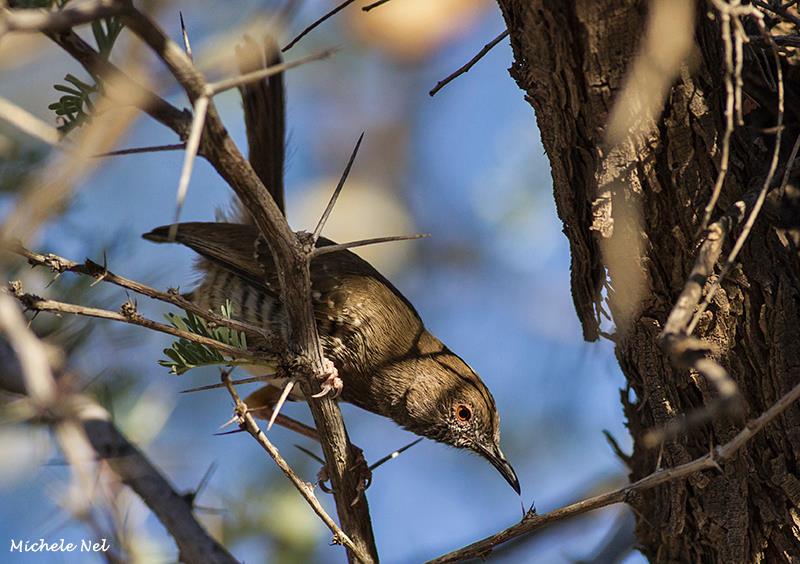 © Michele Nel
© Michele Nel
Kgalagadi Transfrontier Park, Mata Mata, 07/01/2016
Links:
Species text Sabap1
Sabap2
Newman's Birds of Southern Africa
 © Michele Nel
© Michele NelKgalagadi Transfrontier Park, Mata Mata, 07/01/2016
Links:
Species text Sabap1
Sabap2
Newman's Birds of Southern Africa
- Mel
- Global Moderator
- Posts: 26737
- Joined: Sat May 19, 2012 12:31 pm
- Country: Germany
- Location: Föhr
- Contact:
Yellow-bellied Eremomela
653. Yellow-bellied Eremomela Eremomela icteropygialis (Geelpensbossanger)
Order: Passeriformes. Family: Cisticolidae
Description
Short-tailed warbler. The smallest of the eremomelas. It’s about 10 cm with grey upperparts and darker and more olive wings and tail. It’s got a thin pale grey supercilium and a blackish stripe through the eye. The breast is grey and the belly lemon yellow. Its bill is black; eyes red-brown to brown; legs and feet are grey to black. Both sexes are similar.
The juvenile has duller yellow underparts.
The subspecies vary in the amount and intensity of the yellow on the belly. Birds in western southern Africa a have whitish throat and breast. It has a brighter yellow belly and vent in the east than in the west of its range.
Similar species: Distinguished from other eremomelas by the combination of olive-grey to grey upperparts and greyish white throat and breast contrasting with the pale yellow belly. Distinguished from similarly coloured white-eyes by its much smaller size, browner upperparts and the lack of white eye-ring. Easily confused with Grey Penduline Tit.
Distribution
It is found in Western, Eastern and Southern Africa. It has two main populations in Africa; one stretches across the Sahel from Mauritania to Sudan. The other occurs from Ethiopia through Tanzania and Zambia to southern Africa. Here it is fairly common in the shrublands of the Kalahari and the Karoo.
E. i. polioxantha: e Botswana, se Zimbabwe, s Mozambique and ne South Africa
E. i. sharpei: s Angola, n Namibia and w, c Botswana
E. i. viriditincta: ne Namibia, ne Botswana, sw Zambia and nw Zimbabwe
E. i. icteropygialis: c, s Namibia, sw Botswana and nw South Africa
E. i. saturatior: c, s South Africa
Habitat
Open woodland, savanna, and dry scrub.
Diet
The diet includes insects and other small invertebrates. Forages through the foliage of smaller trees.
Breeding
The Yellow-bellied Eremomela is monagamous and constructs a thin walled nest of grass held together with spider webs that it suspends from the outer branches of a tree. Egg-laying season is from about August-January, peaking from September-November. The female lays a clutch of two or three white eggs that hatch after an incubation period of approximately 14 days. The chicks are fed by both adults, leaving the nest after about 15-16 days, remaining under their parents for about 2 more weeks, sometimes more.
It is occasionally parasitized by Klaas’s cuckoo.
Call
The bird’s call is a quick chicku-chichu-chee and it seems to be quite vocal throughout the year. Listen to Bird Call.
Status
A common resident.
Order: Passeriformes. Family: Cisticolidae
Description
Short-tailed warbler. The smallest of the eremomelas. It’s about 10 cm with grey upperparts and darker and more olive wings and tail. It’s got a thin pale grey supercilium and a blackish stripe through the eye. The breast is grey and the belly lemon yellow. Its bill is black; eyes red-brown to brown; legs and feet are grey to black. Both sexes are similar.
The juvenile has duller yellow underparts.
The subspecies vary in the amount and intensity of the yellow on the belly. Birds in western southern Africa a have whitish throat and breast. It has a brighter yellow belly and vent in the east than in the west of its range.
Similar species: Distinguished from other eremomelas by the combination of olive-grey to grey upperparts and greyish white throat and breast contrasting with the pale yellow belly. Distinguished from similarly coloured white-eyes by its much smaller size, browner upperparts and the lack of white eye-ring. Easily confused with Grey Penduline Tit.
Distribution
It is found in Western, Eastern and Southern Africa. It has two main populations in Africa; one stretches across the Sahel from Mauritania to Sudan. The other occurs from Ethiopia through Tanzania and Zambia to southern Africa. Here it is fairly common in the shrublands of the Kalahari and the Karoo.
E. i. polioxantha: e Botswana, se Zimbabwe, s Mozambique and ne South Africa
E. i. sharpei: s Angola, n Namibia and w, c Botswana
E. i. viriditincta: ne Namibia, ne Botswana, sw Zambia and nw Zimbabwe
E. i. icteropygialis: c, s Namibia, sw Botswana and nw South Africa
E. i. saturatior: c, s South Africa
Habitat
Open woodland, savanna, and dry scrub.
Diet
The diet includes insects and other small invertebrates. Forages through the foliage of smaller trees.
Breeding
The Yellow-bellied Eremomela is monagamous and constructs a thin walled nest of grass held together with spider webs that it suspends from the outer branches of a tree. Egg-laying season is from about August-January, peaking from September-November. The female lays a clutch of two or three white eggs that hatch after an incubation period of approximately 14 days. The chicks are fed by both adults, leaving the nest after about 15-16 days, remaining under their parents for about 2 more weeks, sometimes more.
It is occasionally parasitized by Klaas’s cuckoo.
Call
The bird’s call is a quick chicku-chichu-chee and it seems to be quite vocal throughout the year. Listen to Bird Call.
Status
A common resident.
God put me on earth to accomplish a certain amount of things. Right now I'm so far behind that I'll never die.
- Mel
- Global Moderator
- Posts: 26737
- Joined: Sat May 19, 2012 12:31 pm
- Country: Germany
- Location: Föhr
- Contact:
Yellow-bellied Eremomela Photos
653. Yellow-bellied Eremomela Eremomela icteropygialis
 © Mel
© Mel
Kgalagadi Transfrontier Park
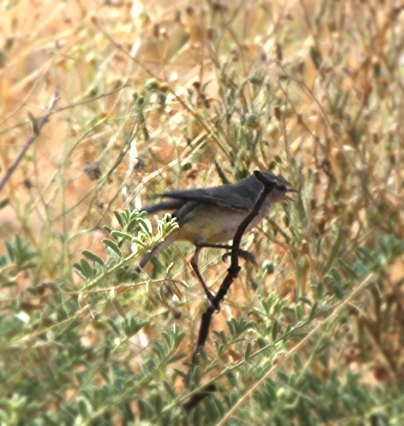 © Tina
© Tina
Lower dune road, Kgalagadi Transfrontier Park
 © nan
© nan
Karoo National Park
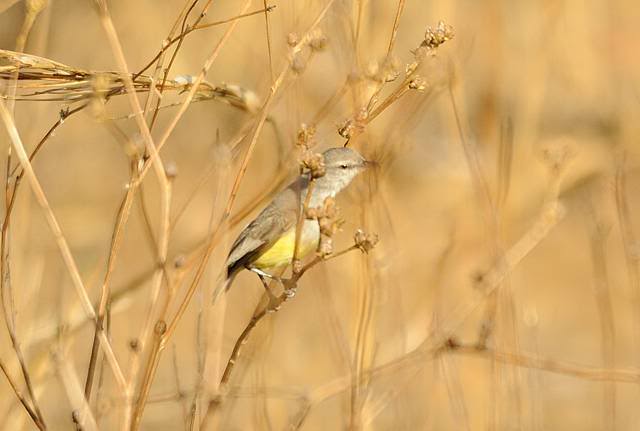 © Dewi
© Dewi
Kruger National Park
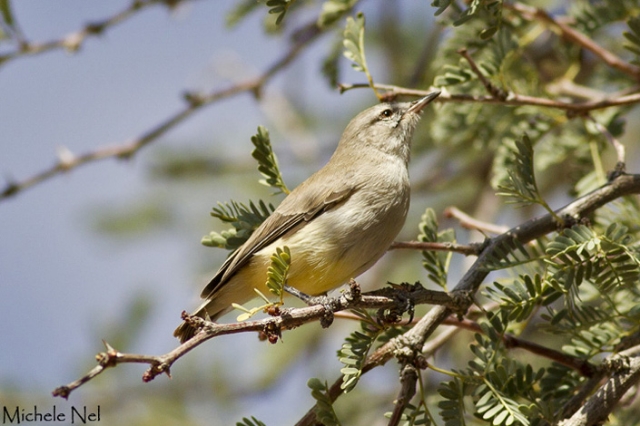 © Michele Nel
© Michele Nel
Sesriem, Namibia
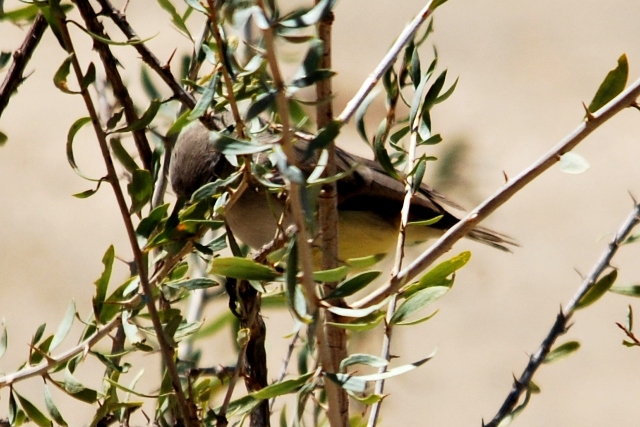
Kgalagadi Transfrontier Park
Links:
Species text Sabap1
Sabap2
 © Mel
© MelKgalagadi Transfrontier Park
 © Tina
© TinaLower dune road, Kgalagadi Transfrontier Park
 © nan
© nanKaroo National Park
 © Dewi
© DewiKruger National Park
 © Michele Nel
© Michele NelSesriem, Namibia

Kgalagadi Transfrontier Park
Links:
Species text Sabap1
Sabap2
God put me on earth to accomplish a certain amount of things. Right now I'm so far behind that I'll never die.
Green-capped Eremomela
655. Green-capped Eremomela Eremomela scotops (Donkerwangbossanger)
Order: Passeriformes. Family: Cisticolidae
Description
11–12 cm; 7–11 g. Greenish cap and face, merging into grey back. Top and side of head greyish-green, dusky streak through lores; upperparts ash-grey. Bright yellow throat and breast. Pale yellow eye.
Juveniles are paler with olive wash above.
Similar species: The bright yellow underparts, greenish upperparts and greenish yellow crown distinguish this species from other eremomelas and similarly coloured warblers.
Distribution
Occurs from the southern half of the DRC through Tanzania, Angola and Zambia to southern Africa.
Subspecies
E. s. congensis: SE Gabon (Lekoni) S to N Angola, E to SW DRCongo (Kasai).
E. s. pulchra: Angola, SE & E DRCongo (Maniema and N end of L Tanganyika S to Katanga), Zambia, W Malawi, NE Namibia, and N Botswana.
E. s. citriniceps: SW Uganda, W Kenya, W Tanzania, Rwanda and Burundi.
E. s. kikuyuensis: C Kenya.
E. s. scotops: coastal Kenya, E Tanzania (inland to Liwale, Songea and Kilosa), E & S Malawi, N & C Mozambique, Zimbabwe and adjacent E Botswana, NE South Africa (Northern Province S to N KwaZulu-Natal) and N Swaziland.
Habitat
It prefers broad-leaved woodland, such as Miombo (Brachystegia), Burkea (Burkea africana) and Zambezi teak (Baikiaea plurijuga), occasionally moving into gardens in south-western Zimbabwe.
Diet
Small insects. Usually forages in groups of 2–8 individuals (either with other Green-capped eremomelas or other species), mainly in tops of tall trees, but sometimes in bushes.
Breeding
It is a facultative cooperative breeder, meaning that the breeding pair are assisted by 1-5 helpers. All members participate in the construction of the nest, which is a small cup made of plant down and buds of Miombo (Brachystegia), secured with spider web. Egg-laying season in Zimbabwe is from August-February, peaking from September-November. It lays 2-5 eggs, which are incubated by all group members.
Call
Dawn song a monotonous twip-twip-twip-twip-twip-twip. Contact and alarm calls consist of very guttural continuous short churrs and a chattering srrrrr-srrrr-srrrrr.
Status
Locally common throughout most of range. Uncommon and localised resident in South Africa.
Order: Passeriformes. Family: Cisticolidae
Description
11–12 cm; 7–11 g. Greenish cap and face, merging into grey back. Top and side of head greyish-green, dusky streak through lores; upperparts ash-grey. Bright yellow throat and breast. Pale yellow eye.
Juveniles are paler with olive wash above.
Similar species: The bright yellow underparts, greenish upperparts and greenish yellow crown distinguish this species from other eremomelas and similarly coloured warblers.
Distribution
Occurs from the southern half of the DRC through Tanzania, Angola and Zambia to southern Africa.
Subspecies
E. s. congensis: SE Gabon (Lekoni) S to N Angola, E to SW DRCongo (Kasai).
E. s. pulchra: Angola, SE & E DRCongo (Maniema and N end of L Tanganyika S to Katanga), Zambia, W Malawi, NE Namibia, and N Botswana.
E. s. citriniceps: SW Uganda, W Kenya, W Tanzania, Rwanda and Burundi.
E. s. kikuyuensis: C Kenya.
E. s. scotops: coastal Kenya, E Tanzania (inland to Liwale, Songea and Kilosa), E & S Malawi, N & C Mozambique, Zimbabwe and adjacent E Botswana, NE South Africa (Northern Province S to N KwaZulu-Natal) and N Swaziland.
Habitat
It prefers broad-leaved woodland, such as Miombo (Brachystegia), Burkea (Burkea africana) and Zambezi teak (Baikiaea plurijuga), occasionally moving into gardens in south-western Zimbabwe.
Diet
Small insects. Usually forages in groups of 2–8 individuals (either with other Green-capped eremomelas or other species), mainly in tops of tall trees, but sometimes in bushes.
Breeding
It is a facultative cooperative breeder, meaning that the breeding pair are assisted by 1-5 helpers. All members participate in the construction of the nest, which is a small cup made of plant down and buds of Miombo (Brachystegia), secured with spider web. Egg-laying season in Zimbabwe is from August-February, peaking from September-November. It lays 2-5 eggs, which are incubated by all group members.
Call
Dawn song a monotonous twip-twip-twip-twip-twip-twip. Contact and alarm calls consist of very guttural continuous short churrs and a chattering srrrrr-srrrr-srrrrr.
Status
Locally common throughout most of range. Uncommon and localised resident in South Africa.
Green-capped Eremomela Photos
655. Green-capped Eremomela Eremomela scotops
 © BluTuna
© BluTuna
Kruger National Park, Tsendze camp
Links:
Species text Sabap1
Sabap2
 © BluTuna
© BluTunaKruger National Park, Tsendze camp
Links:
Species text Sabap1
Sabap2
-
Michele Nel
- Posts: 1994
- Joined: Mon Sep 10, 2012 10:19 am
- Country: South Africa
- Location: Cape Town
- Contact:
Karoo Eremomela
654. Karoo Eremomela Eremomela gregalis (Groenbossanger)
Order: Passeriformes. Family: Cisticolidae
Description
12 cm. A long-tailed eremomela distinguished by its olive-green upperparts, shading to greyer on the face and neck and contrasting with silvery white underparts. Yellow flanks and undertail. Note uniformly coloured tail. Pale yellow eyes.
The unmarked silvery white underparts distinguish this from other eremomelas.
Distribution
Endemic to Southern Africa. It is fairly common, with the bulk of its of population centered on the Karoo.
Habitat
Arid and semi-arid bush on flats and hillsides.
Diet
It mainly eats invertebrates, gleaning them from shrubs and tree branches and occasionally plucking prey from the ground.
Breeding
It is a facultative cooperative breeder, with all group members helping with the gathering of twigs, Old-Man's Beard (Galium tomentosum) and dry grass for the nest. This consists of a thick walled cup lined with the fluffy seeds of Karoo rosemaries (Eriocephalus) and typically placed in a forked branch deep within a small bush. Egg-laying season is almost year-round, peaking from August-October. It lays 2-4 eggs, which are probably incubated by both sexes for at least 11 days. Not much information is available about the chicks, other than that they are fed by all members of the group.
Status
Uncommon, localised endemic resident.
Order: Passeriformes. Family: Cisticolidae
Description
12 cm. A long-tailed eremomela distinguished by its olive-green upperparts, shading to greyer on the face and neck and contrasting with silvery white underparts. Yellow flanks and undertail. Note uniformly coloured tail. Pale yellow eyes.
The unmarked silvery white underparts distinguish this from other eremomelas.
Distribution
Endemic to Southern Africa. It is fairly common, with the bulk of its of population centered on the Karoo.
Habitat
Arid and semi-arid bush on flats and hillsides.
Diet
It mainly eats invertebrates, gleaning them from shrubs and tree branches and occasionally plucking prey from the ground.
Breeding
It is a facultative cooperative breeder, with all group members helping with the gathering of twigs, Old-Man's Beard (Galium tomentosum) and dry grass for the nest. This consists of a thick walled cup lined with the fluffy seeds of Karoo rosemaries (Eriocephalus) and typically placed in a forked branch deep within a small bush. Egg-laying season is almost year-round, peaking from August-October. It lays 2-4 eggs, which are probably incubated by both sexes for at least 11 days. Not much information is available about the chicks, other than that they are fed by all members of the group.
Status
Uncommon, localised endemic resident.
-
Michele Nel
- Posts: 1994
- Joined: Mon Sep 10, 2012 10:19 am
- Country: South Africa
- Location: Cape Town
- Contact:
Karoo Eremomela Photos
654. Karoo Eremomela Eremomela gregalis (Groenbossanger)

Links:
Species text Sabap1
Sabap2
Biodiversity Explorer

Links:
Species text Sabap1
Sabap2
Biodiversity Explorer
Burnt-necked Eremomela
656. Burnt-necked Eremomela Eremomela usticollis (Bruinkeelbossanger)
Order: Passeriformes. Family: Cisticolidae
Description
Size 10 cm. A small warbler with blue-grey back and yellow or buff wash to the underparts. Breeding birds show a rufous cheek mark and line on the breast. Note the pale eye.
Distribution
Sub-Saharan Africa. In Southern Africa: Northeastern Namibia, northern & eastern Botswana, Zimbabwe, western Mozambique, northeastern South Africa and eSwatini.
E. u. rensi: e Zambia to c Zimbabwe and c Mozambique
E. u. usticollis: s Angola and Namibia to s Mozambique and e South Africa
Habitat
Thornveld.
Diet
They eat mainly arthropods gleaned from leaves, twigs and branches.
Breeding
Monogamous and territorial. The nest is an cup built of twigs and other plant material by both sexes, between 2 and 10 m above the ground in the Acacia canopy. It is typically suspended from a few twigs. Egg-laying season is from September-April, peaking from October-March. One to four eggs are laid and incubated for 13-14 days by both sexes. The chicks are brooded and fed by both of their parents.
Call
The male calls year-round; voice is varied, but the most common call is a kew-tee-tee-tee-tee-tee whistle. Listen to bird Call.
Status
Fairly common resident in suitable habitat.
Order: Passeriformes. Family: Cisticolidae
Description
Size 10 cm. A small warbler with blue-grey back and yellow or buff wash to the underparts. Breeding birds show a rufous cheek mark and line on the breast. Note the pale eye.
Distribution
Sub-Saharan Africa. In Southern Africa: Northeastern Namibia, northern & eastern Botswana, Zimbabwe, western Mozambique, northeastern South Africa and eSwatini.
E. u. rensi: e Zambia to c Zimbabwe and c Mozambique
E. u. usticollis: s Angola and Namibia to s Mozambique and e South Africa
Habitat
Thornveld.
Diet
They eat mainly arthropods gleaned from leaves, twigs and branches.
Breeding
Monogamous and territorial. The nest is an cup built of twigs and other plant material by both sexes, between 2 and 10 m above the ground in the Acacia canopy. It is typically suspended from a few twigs. Egg-laying season is from September-April, peaking from October-March. One to four eggs are laid and incubated for 13-14 days by both sexes. The chicks are brooded and fed by both of their parents.
Call
The male calls year-round; voice is varied, but the most common call is a kew-tee-tee-tee-tee-tee whistle. Listen to bird Call.
Status
Fairly common resident in suitable habitat.
Dewi
What is the good of having a nice house without a decent planet to put it on? (H D Thoreau)
What is the good of having a nice house without a decent planet to put it on? (H D Thoreau)
Burnt-necked Eremomela Photos
656. Burnt-necked Eremomela Eremomela usticollis (Bruinkeelbossanger)
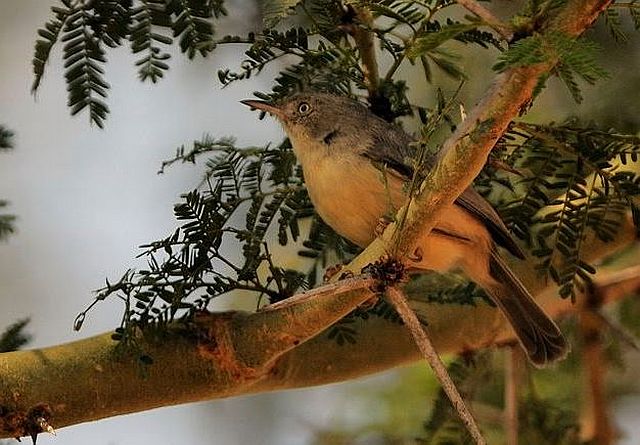
Links:
Species text Sabap1
Sabap2

Links:
Species text Sabap1
Sabap2
Dewi
What is the good of having a nice house without a decent planet to put it on? (H D Thoreau)
What is the good of having a nice house without a decent planet to put it on? (H D Thoreau)


